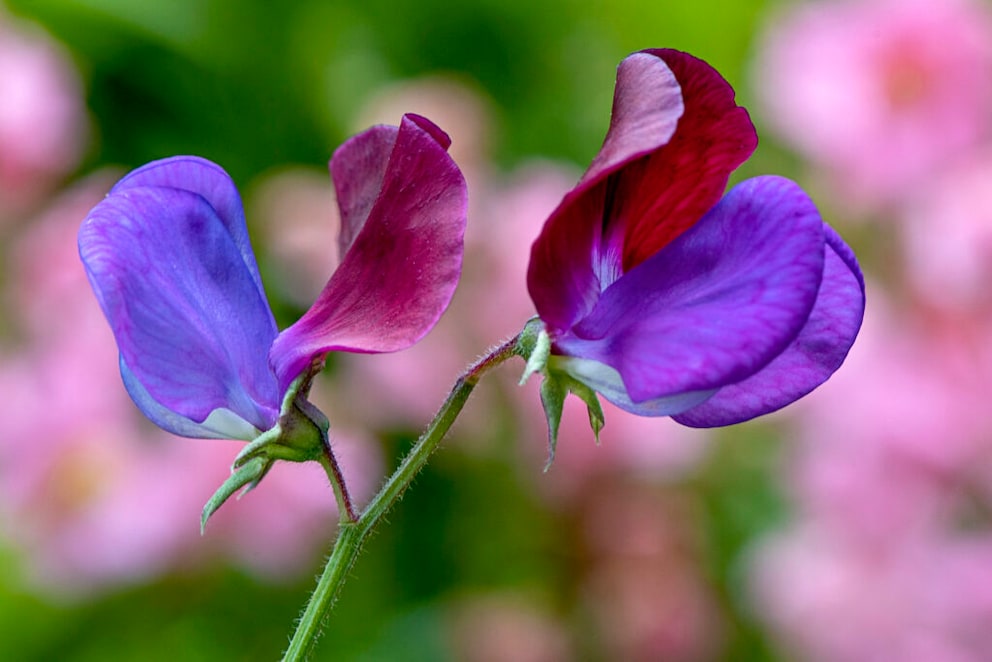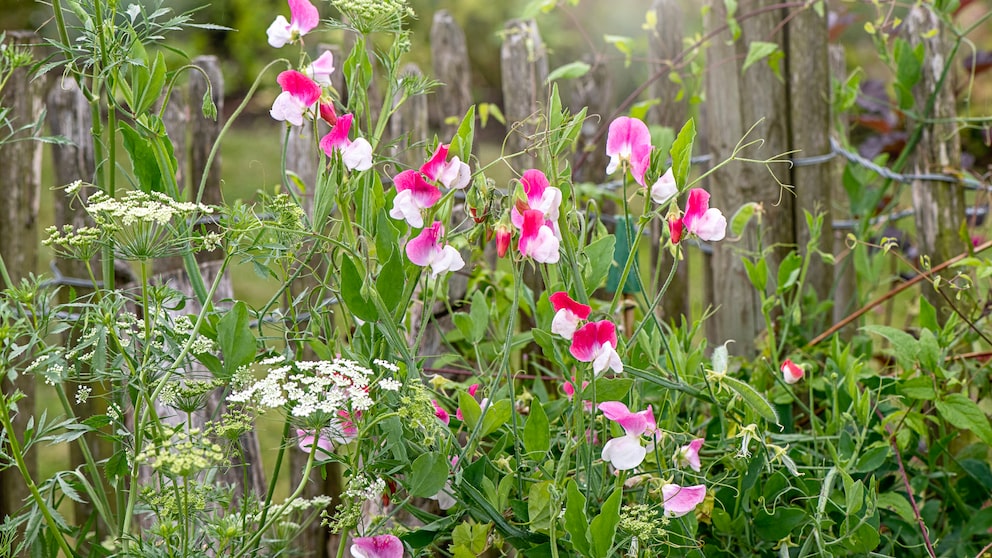April 21, 2025, 12:16 pm | Read time: 4 minutes
Sweet pea is also known as “fragrant pea” and is actually related to the plant from the vegetable patch. However, it is particularly impressive because of its colorful butterfly flowers. In England, separate breeding societies have even been founded because of the beauty of the sweet pea. With the right care, sweet peas also thrive here.
An unsightly fence or a bare house wall? Fragrant climbing plants can provide a beautiful and fragrant remedy. Depending on the variety, they can climb as high as 150 centimetres with their delicate tendrils, producing hundreds of magnificent flowers throughout the summer. In keeping with their name, they exude a beguiling, summery fragrance. Therefore, sweet pea is a must-have in any cottage garden. Additionally, a balcony railing can be quickly and attractively adorned with these vigorous climbing plants.
Overview
Planting Sweet Pea
From March to April, sweet pea seeds can be grown in a greenhouse or on a windowsill. Direct outdoor sowing is also an option starting from mid to late April. In either case, the pea-shaped seeds should be placed in water overnight to swell and initiate the germination process. Then, place them about five centimetres deep in the soil with a hand-width distance to the next planting hole. It will now take around a fortnight for the first sweet pea plants to emerge. Once the first pair of leaves has unfolded, the sprout tip can be broken out. This encourages the growth of the side shoots, which produce the most flowers.
Appearance and Growth
Sweet pea is an herbaceous plant that can grow up to 150 centimetres tall. The delicate tendrils that support the leaves and flowers are also characteristic. The latter bloom throughout the summer from June to September. Varieties are available that bloom in red, pink, purple, or white, as well as those with mixed colors featuring gradients of these hues. In the fall, similar to peas, long pods hang from the plants in which the seeds can be found. These can be used for re-sowing in spring.

Location and Soil
The ideal location for sweet peas is a semi-shady spot, sheltered from the wind, with support for climbing. Evenly moist soil that neither dries out completely nor is waterlogged is best for the sweet pea.
Sweet Pea Varieties
The sweet pea’s immense popularity and the founding of breeding societies in England have resulted in an extensive variety of strains. Depending on the variety, the focus is either on the colors of the magnificent flowers or the lovely, eponymous scent.
- Cupani: This fragrant climbing plant variety is considered to be the origin of all fragrant climbing plants. It is named after its discoverer, Father Franciscus Cupani, who probably found it near Palermo. Cupani has rather small flowers with a strong fragrance.
- Spencer: There are several varieties of Spencer, all of which are considered to be very floriferous. However, this is at the expense of the sweet scent of the plant. In general, varieties with a particularly large number of flowers are less fragrant than others.
- Lord Nelson: Like Cupani, the Lord Nelson variety is one of the older ones. The dark blue flowers have a particularly intense fragrance.
Caring for Sweet Pea
Once sown and sprouted, sweet peas require minimal maintenance. It is particularly important to ensure that they can climb well and that the soil never dries out completely.
Watering
Waterlogging and drought are the biggest enemies of sweet pea. In long, hot summers, it should, therefore, be watered a little every day. The soil should be well-draining to prevent water accumulation.
Fertilizing
Compost can be added to the soil around the sweet peas several times during the growing season. The magnificent flowering plants have a high nutrient requirement.
Pruning Sweet Pea
Regular pruning encourages the formation of new flowers. This is another reason why sweet peas are so popular. Fresh cut flowers can be taken almost daily to bring the scent of sweet peas into your home.
Toxicity
Unlike its relative the pea, the sweet pea is poisonous—especially the seeds. In gardens where small children play, it’s important to plant sweet peas out of their reach.

Use
Looking for a green, beautifully blooming privacy screen that also offers a delightful fragrance? Fragrant climbing plants are ideal for greening trellises, balconies or fences. Sweet peas can also serve as an intermediate planting in flower beds. The roots of sweet peas fix nitrogen in the soil. When plowed under, they act as a powerful green manure.

Planting and care tips for lupins in the garden

Planting and care tips for cosmos

6 hardy potted plants for the garden and balcony
Diseases and Pests
Aphids love sweet peas. Natural control methods, such as introducing ladybug larvae, can quickly mitigate the problem. Powdery mildew is also a problem that occurs more frequently. The sooner mild pesticides are applied, the more effective they tend to be. In general, sweet peas are more resistant to pests and diseases when grown in optimal conditions.

